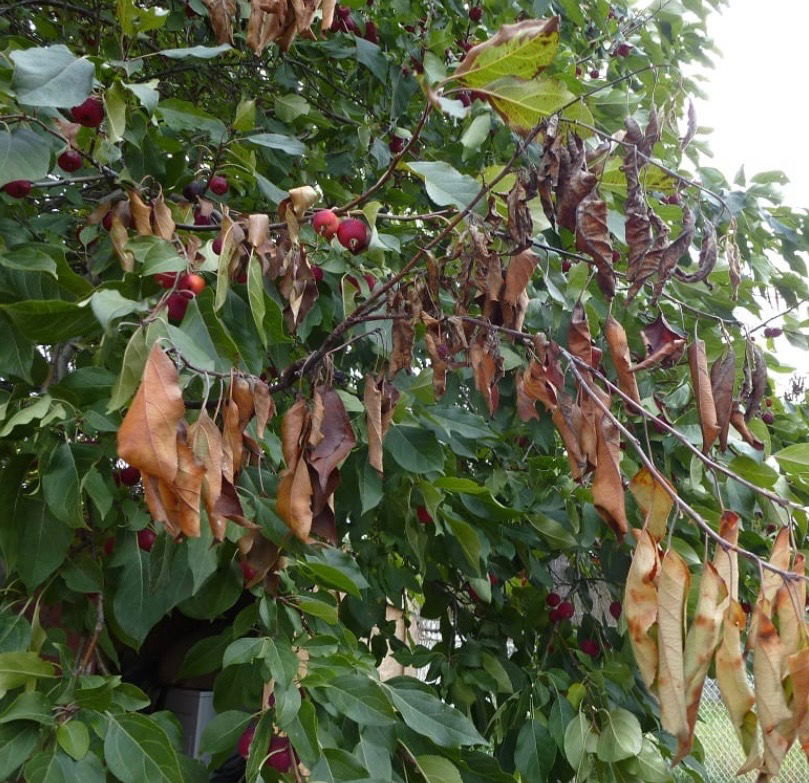As an arborist, or homeowner in general, it’s important to understand how to recognize and treat common tree diseases. Trees are an essential part of the environment, providing shade, oxygen, and aesthetic beauty. However, they are susceptible to a range of diseases that can impact their health and longevity.
In this blog post, we’ll discuss some of the most common tree diseases in Edmonton and provide tips for recognizing and treating them.
Common Tree Diseases
Dutch Elm Disease (DED)
DED is a fungal disease that affects elm trees. It is spread by bark beetles and can cause rapid decline in infected trees. Symptoms of DED include yellowing and wilting of leaves, branch dieback, and the formation of brown streaks in the sapwood. If left untreated, DED can kill an elm tree within a few years.
In Alberta, a ban on Elm Pruning was introduced to prevent the spread of DED , which seems to be working, as there are no known cases of DED in the province.
European Elm Scale

European elm scale is a serious pest that can affect the health of elm trees. These small, oval-shaped insects feed on the sap of the tree and secrete a sugary substance called honeydew, which can attract other pests and promote the growth of sooty mold. The infestation can cause yellowing leaves, branch dieback, and even tree death. The European elm scale is commonly found in Europe but has also been introduced to North America. Elm trees in Edmonton are susceptible to European Elm Scale.
Fire Blight

Fire blight is a bacterial disease that affects fruit trees, such as apple and pear trees. It is spread by insects and can cause wilting, blackening, and death of branches and shoots. Infected trees may also exhibit oozing of sap or bacterial exudate from infected areas.
Cedar Rust

Cedar rust is a fungal disease that affects cedar and juniper trees. It is spread by spores that infect apple and crabapple trees, causing yellowing and premature leaf drop. Infected trees may also exhibit the formation of orange-colored pustules on leaves and fruit.
Pine Wilt Disease
Pine wilt disease is caused by a nematode and affects pine trees. Symptoms include wilting and browning of needles, branch dieback, and eventual death of the tree. The disease is spread by insects and can be difficult to control once a tree is infected.
Black Knot

Black knot is a fungal disease that affects plum and cherry trees. It causes the formation of black, rough galls on branches, which can eventually kill the tree. Infected trees may also exhibit wilting and dieback of branches.
Recognizing Tree Diseases
Recognizing tree diseases early is key to effective treatment. Here are some signs to look for when inspecting your trees:
Discolored or Wilting Leaves
Discolored or wilting leaves can be a sign of disease or pest infestation. Pay attention to any unusual leaf patterns or colors, such as yellowing or blackening.
Dead or Dying Branches
Dead or dying branches can indicate disease or pest damage. If you notice branches that are brown, brittle, or lacking leaves, it may be a sign of a more serious problem.
Cankers
Cankers are areas of dead bark on a tree trunk or branch. They can be caused by fungal or bacterial infections and can be a sign of a more serious problem.
Oozing or Weeping
If you notice sap or bacterial exudate oozing from a tree trunk or branch, it may be a sign of a disease or pest infestation.
Galls
Galls are abnormal growths on a tree, often caused by insect or fungal infestation. They can be a sign of a more serious problem and may need to be removed.
Treating Tree Diseases
Effective treatment of tree diseases depends on early detection and prompt action. Here are some tips for treating common tree diseases:
Pruning
Pruning infected branches can help prevent the spread of disease to other parts of the tree. Make sure to use clean, sterilized pruning tools to avoid spreading the disease further.
Fertilization
Fertilizing infected trees can help improve their overall health and increase their ability to fight off disease.
Chemical Treatments
Chemical treatments, such as fungicides or insecticides, can be used to treat some tree diseases. However, it’s important to use these treatments judiciously and only after consulting with an arborist or other tree care professional.
Prevention
The best way to prevent tree diseases is through proper care and maintenance. This includes regular watering and fertilization, as well as pruning and removing dead or diseased branches.
Removal
In some cases, the best course of action may be to remove an infected tree. This is particularly true if the disease is widespread or if the tree is a safety hazard.
Conclusion
Tree diseases can be a serious threat to the health and longevity of your trees. By recognizing the signs of common tree diseases and taking prompt action, you can help ensure that your trees remain healthy and vibrant for years to come. If you suspect that your trees may be infected with a disease, it’s important to consult with an arborist or other tree care professional to determine the best course of action.
Remember, the best defense against tree diseases is prevention. By providing your trees with the proper care and maintenance they need, you can help ensure that they remain healthy and vibrant for many years to come. So, take the time to inspect your trees regularly, and don’t hesitate to seek professional help if you suspect that your trees may be suffering from a disease.

